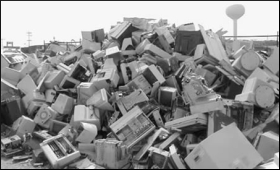|

|
'Need to bring out effective legislation to prevent child labour'
|
|

|
|
| Top Stories |
 |
|
|
|
SME Times News Bureau | 22 Apr, 2014
Over 4.5 lakhs child labours between the age group of 10-14 are observed to be engaged in various e-waste (electronic waste) activities in India, without adequate protection and safeguards in various yards and recycling workshops, according to the ASSOCHAM recent study on 'Earth Day' (April 22).
While releasing the paper, D S Rawat, Secretary General ASSOCHAM said, the informal recycling industry often employs children to dismantle electronic waste. ASSOCHAM's report strongly advocates legislation to prevent a child's entry into this labour market. The chamber has also strongly advocated the need to bring out effective legislation to prevent entry of child labour into its collection, segregation and distribution.
A meager 4 percent of India's total e-waste gets recycled due to poor infrastructure, legislation and framework which lead to a waste of diminishing natural resources, irreparable damage of environment and health of the people working in industry. Over 95 percent of e-waste generated is managed by the unorganised sector and scrap dealers in this market, dismantle the disposed products instead of recycling it," according to a study on 'Electronic Waste Management in India,' jointly conducted by The Associated Chambers of Commerce and Industry of India (ASSOCHAM) and Frost & Sullivan and released on "Earth Day".
As per the study, India is likely to generate e-waste to an extent of 15 Lakh metric tonnes (MT) per annum by 2015 from the current level 12.5 Lakh MT per annum growing at a compound annual growth rate (CAGR) of about 25 percent.
India's produces nearly 12.5 Lakhs MT of electronic waste every year. Mumbai (96,000) tops the list in generating e-waste followed Delhi-NCR (67,000) and Bangalore (57,000) says the ASSOCHAM paper. Chennai, Kolkata, Ahemdabad, Hyderabad and Pune find a place in the ladder, at 47,000, 35,000, 26,000, 25,000 and 19,000 metric tonnes per year respectively, reveals the study.
Computer equipment accounts for almost 68 percent of e-waste material followed by telecommunication equipment (12 percent), electrical equipment (8 percent) and medical equipment (7 percent). Other equipment, including household e-crap account for the remaining 5 percent, it said.
"E-waste typically includes discarded computer monitors, motherboards, Cathode Ray Tubes (CRT), Printed Circuit Board (PCB), mobile phones and chargers, compact discs, headphones, white goods such as Liquid Crystal Displays (LCD)/ Plasma televisions, air conditioners, refrigerators and so on. With increasing use of these in our everyday life, e-waste is also piling up. Almost half of all unused and end-of-life electronic products lie idle in landfills, junkyards and warehouses," it said.
Rawat said, "e-waste is directly linked to the economic growth of the country and also overall consumer spending pattern. India’s economic growth has lifted millions of people from lower-income group to middle and high-income groups and increased purchasing power".
More than 70 per cent of e-waste contributors are government, public and private industries, while household waste contributes about 15 per cent. Televisions, refrigerators and washing machines make up the majority of e-waste, while computers account for another 20 per cent and mobile phones 2 per cent, adds the report.
|
|
|
| |
|
|
|
|
|
|
|
|
|
|
|
|
|
|
| |
| Customs Exchange Rates |
| Currency |
Import |
Export |
US Dollar
|
66.20
|
64.50 |
UK Pound
|
87.50
|
84.65 |
Euro
|
78.25
|
75.65 |
| Japanese
Yen |
58.85 |
56.85 |
| As on 13 Aug, 2022 |
|
|
| Daily Poll |
 |
 |
| PM Modi's recent US visit to redefine India-US bilateral relations |
|
|
|
|
|
| Commented Stories |
 |
|
|
|
|
|
| |
|